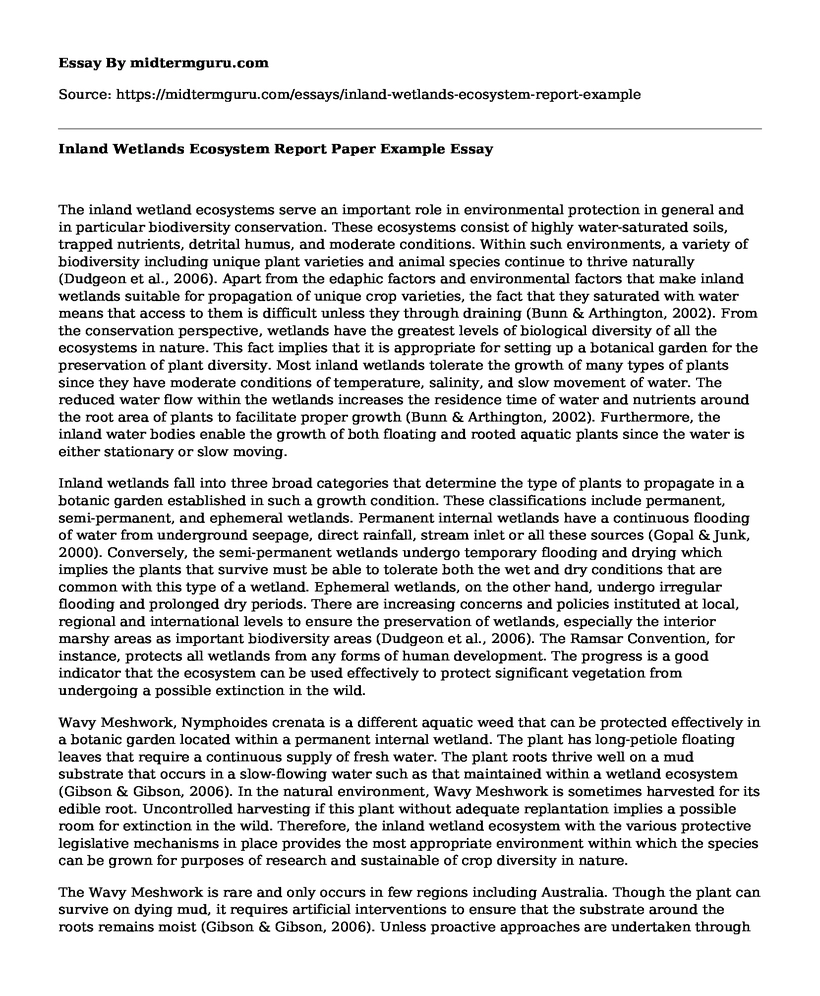The inland wetland ecosystems serve an important role in environmental protection in general and in particular biodiversity conservation. These ecosystems consist of highly water-saturated soils, trapped nutrients, detrital humus, and moderate conditions. Within such environments, a variety of biodiversity including unique plant varieties and animal species continue to thrive naturally (Dudgeon et al., 2006). Apart from the edaphic factors and environmental factors that make inland wetlands suitable for propagation of unique crop varieties, the fact that they saturated with water means that access to them is difficult unless they through draining (Bunn & Arthington, 2002). From the conservation perspective, wetlands have the greatest levels of biological diversity of all the ecosystems in nature. This fact implies that it is appropriate for setting up a botanical garden for the preservation of plant diversity. Most inland wetlands tolerate the growth of many types of plants since they have moderate conditions of temperature, salinity, and slow movement of water. The reduced water flow within the wetlands increases the residence time of water and nutrients around the root area of plants to facilitate proper growth (Bunn & Arthington, 2002). Furthermore, the inland water bodies enable the growth of both floating and rooted aquatic plants since the water is either stationary or slow moving.
Inland wetlands fall into three broad categories that determine the type of plants to propagate in a botanic garden established in such a growth condition. These classifications include permanent, semi-permanent, and ephemeral wetlands. Permanent internal wetlands have a continuous flooding of water from underground seepage, direct rainfall, stream inlet or all these sources (Gopal & Junk, 2000). Conversely, the semi-permanent wetlands undergo temporary flooding and drying which implies the plants that survive must be able to tolerate both the wet and dry conditions that are common with this type of a wetland. Ephemeral wetlands, on the other hand, undergo irregular flooding and prolonged dry periods. There are increasing concerns and policies instituted at local, regional and international levels to ensure the preservation of wetlands, especially the interior marshy areas as important biodiversity areas (Dudgeon et al., 2006). The Ramsar Convention, for instance, protects all wetlands from any forms of human development. The progress is a good indicator that the ecosystem can be used effectively to protect significant vegetation from undergoing a possible extinction in the wild.
Wavy Meshwork, Nymphoides crenata is a different aquatic weed that can be protected effectively in a botanic garden located within a permanent internal wetland. The plant has long-petiole floating leaves that require a continuous supply of fresh water. The plant roots thrive well on a mud substrate that occurs in a slow-flowing water such as that maintained within a wetland ecosystem (Gibson & Gibson, 2006). In the natural environment, Wavy Meshwork is sometimes harvested for its edible root. Uncontrolled harvesting if this plant without adequate replantation implies a possible room for extinction in the wild. Therefore, the inland wetland ecosystem with the various protective legislative mechanisms in place provides the most appropriate environment within which the species can be grown for purposes of research and sustainable of crop diversity in nature.
The Wavy Meshwork is rare and only occurs in few regions including Australia. Though the plant can survive on dying mud, it requires artificial interventions to ensure that the substrate around the roots remains moist (Gibson & Gibson, 2006). Unless proactive approaches are undertaken through the establishment of a botanical garden established within inland wetlands, it will be likely to lose the Wavy Meshwork in the wilderness meaning reduced ability of scientific research to use it for any research and developments in the field of medicine or nutrition.
References
Bunn, S. E., & Arthington, A. H. (2002). Basic principles and ecological consequences of altered flow regimes for aquatic biodiversity. Environmental Management, 30(4), 492-507.
Dudgeon, D., Arthington, A. H., Gessner, M. O., Kawabata, Z. I., Knowler, D. J., Leveque, C., & Sullivan, C. A. (2006). Freshwater biodiversity: importance, threats, status and conservation challenges. Biological Reviews, 81(2), 163-182.
Gibson, J. P., & Gibson, T. R. (2006). Plant Ecology. New York: Infobase Pub.
Gopal, B., & Junk, W. J. (2000). Of Book: Biodiversity in wetlands: assessment, function, and conservation. Vol. 2. Backhuys Publishers.
Cite this page
Inland Wetlands Ecosystem Report Paper Example. (2021, Jul 02). Retrieved from https://midtermguru.com/essays/inland-wetlands-ecosystem-report-example
If you are the original author of this essay and no longer wish to have it published on the midtermguru.com website, please click below to request its removal:
- Essay on the Future of Renewable Energy in Turkey
- Discussion Questions on Environmental Governance - Paper Example
- The Effects of Ocean Trash on Marine and Human Life - Essay Sample
- Carlton Watkins: Instrumental in Advocating for Environmentalism - Essay Sample
- Article Analysis Essay on "What Is Global Warming, Explained" by Christina Nunez
- Driverless Cars: A Solution to Global Warming? - Essay Sample
- Myanmar Floods: A Continuous Crisis in the East - Essay Sample







